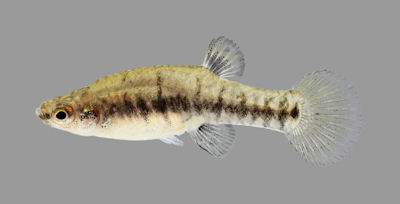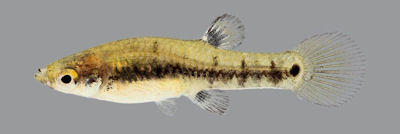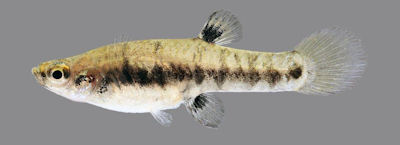Fish in Focus: Least Killifish, Heterandria formosa

Least Killifish, Heterandria formosa
All photos by Uland Thomas
Least Killifish, Heterandria formosa
(Originally published in American Currents Summer 2012 by Thomas P. Ganley)
This species is another outstanding little fish from the southeastern United States. The females are barely one-inch long and the males are usually a third that size. Lively, sociable, and easy to keep, it eats anything, adapts easily to most water types, and constantly breeds. The Least Killifish is one of the two smallest vertebrate animals in the United States. Actually, the male may be the smallest vertebrate animal in the entire word.
Iíve caught the Least Killifish in several types of water. Iíve caught them in hard, clear, alkaline water in the Florida Everglades region; dark, acidic, tannin-stained water in the Okefenokee region of Georgia; and some brackish-influenced drainage ditches in Carolina. Though in the book Fishes of Okefenokee Swamp by Laerrn and Freeman (1986), the authors state that the Least Killifish is not found in the swamp or its immediate drainage, I often catch them in an outflow from the park by the southern entrance to the National Wildlife Refuge in Folkston, GA, outside of the park boundaries. The Least Killifish, of course, is much more common east and west of Okefenokee Swamp.

|

|
I keep mine in the hard alkaline water straight from the tap. I add a little dechlorinator and a little dissolved aquarium salt. I have found that with the Least Killifish or with any of my wild livebearers, that the addition of a little salt seems to keep them in better health and prevents fin-clamping. The Least Killifish is another fish often found in dense plant growth or along the edges of plant growth, usually in relatively shallow water. They are social and often travel in large groups. There is one spot in Georgia where I often catch hundreds with little effort in very shallow water over the sand bottom of a boat launch.
My aquarium set-ups for Least Killifish are very basic in form and function. I filter the tanks with sponge filters set with a low air flow only. The females drop fry continuously as opposed to a large batch at once. The fry are so small that they easily get sucked into the box filters, even with a low air flow. By using just a sponge filter, the fry have a better chance for survival. I have found that by the time I can see the fry in the tank, they are capable of eating baby brine shrimp.
I have successfully kept mine with pygmy sunfish Elassoma species, Pygmy Killifish (Leptolucania ommata), and Bluefin Killifish (Lucania goodei). Swamp Darters (Etheostoma fusiforme) will not harm the adults but will actively hunt down the fry. I also made an interesting discovery concerning Least Killifish. I assumed that they were too fast to be caught by newts in a deep tank and that newts were too slow to hunt down fish in the open water. Neither was accurate. My group of Eastern Newts ate nearly 60 Least Killifish in an hour so newts should be scratched off the list as potential tank mates.
Reference:
Laerm, J. and B. J. Freeman. 1986. Fishes of Okefenokee Swamp. The University of Georgia Press. 118 pp.